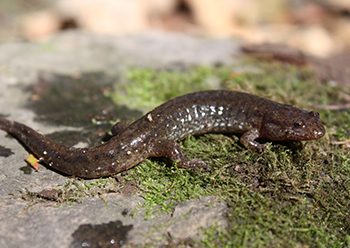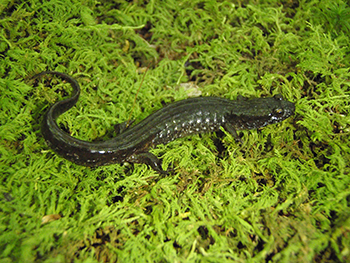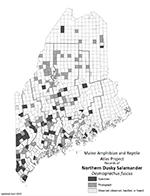Home → Fish & Wildlife → Wildlife → Species Information → Reptiles & Amphibians → Northern Dusky Salamander
Northern Dusky Salamander
Desmognathus fuscus
On this page:

Photo: Trevor Persons
Distinguishing Characteristics

Photo: Trevor Persons
- Moderately sized, approximately 2.5 to 4.5 inches in length
- Highly variable coloration, but generally brownish, dark brown, or black, with a gray underside
- May have light flecking along lower sides
- Hind legs much thicker and stockier than front legs
- Light diagonal line from behind eye to rear of jaw
- Tail has a raised ridge along top to aid salamander in swimming
Status and Distribution in Maine
- Common
- Southern, central, and northern regions
Habitat
- Along the edges of rocky streams, springs, and seeps
Diet
- Carnivorous, feeds on small terrestrial or aquatic invertebrates such as insects, worms, spiders, and mollusks
Seasonal Changes
- Overwinters underground, below frost level, near streams, springs, and seeps
Natural History Notes
- Highly aquatic, one of three species of "brook" or "stream" salamanders in Maine
- Lays eggs under rocks or logs along the edges of stream
Share Your Sighting
There is much still to learn about the distribution and ecology of Maine’s herpetofauna, and we encourage members of the public to share their photo-documented observations as part of the Maine Amphibian & Reptile Atlas Project (MARAP).
To see if a township still needs documentation of a species, consult this distribution map (PDF). If a township lacks a photo or specimen record, we want your observation!
There are two ways to share your observations:
Submit your reptile or amphibian observation online
No service? No problem. Click here to download the survey to your device while connected, then take offline to collect observations from anywhere. Tip: The survey works best on Google Chrome and Safari.
Or upload sightings to the iNaturalist citizen science project through their website at iNaturalist.org or mobile app.
- When submitting an observation through iNaturalist add a description of the location (and other noteworthy information) to the “notes” field. This serves as a check on the locations automatically generated by smartphone cameras, which may be imprecise if cell service or GPS coverage is weak.
Thank you for doing your part to help conserve Maine’s reptiles and amphibians.
